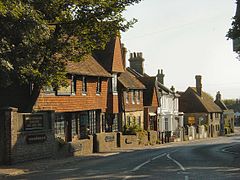Rickney
| Pevensey | |
|---|---|
 Pevensey High Street |
|
| Pevensey shown within East Sussex | |
| Area | 17.6 km2 (6.8 sq mi) |
| Population | 3,153 (2011) |
| • Density | 464/sq mi (179/km2) |
| OS grid reference | TQ635052 |
| • London | 50 miles (80 km) NNW |
| District | |
| Shire county | |
| Region | |
| Country | England |
| Sovereign state | United Kingdom |
| Post town | PEVENSEY |
| Postcode district | BN24 |
| Dialling code | 01323 |
| Police | Sussex |
| Fire | East Sussex |
| Ambulance | South East Coast |
| EU Parliament | South East England |
| UK Parliament | |
| Website | Parish Council |
Pevensey is a village and civil parish in the Wealden district of East Sussex, England. The main village is located 5 miles (8 km) north-east of Eastbourne, one mile (1.6 km) inland from Pevensey Bay. The settlement of Pevensey Bay forms part of the parish. It was here that William the Conqueror made the landing in his invasion of England in 1066 after crossing the English Channel from Normandy, France.
Pevensey is situated on a spur of sand and clay, about 10 metres (33 ft) above sea level. In Roman times this spur was a peninsula that projected into a tidal lagoon and marshes. A small river, Pevensey Haven, runs along the north side of the peninsula and would originally have discharged into the lagoon, but is now largely silted up. The lagoon extended inland as far north as Hailsham and eastwards to Hooe. With the effect of longshore drift this large bay was gradually cut off from the sea by shingle, so that today's marshes are all that remain behind the shingle beach.
The marshes, known as the Pevensey Levels, cover an area of around 47 miles² (120 km²). They are a Site of Special Scientific Interest and a large nature reserve, jointly owned by Natural England and the Sussex Wildlife Trust. There are many nationally rare plants and invertebrates, including the fen raft spider. The site is very fragile and general access is not permitted.
The settlement of Pevensey Bay lies behind and on the shingle beach. Although small, it is nevertheless a seaside resort in miniature, and has many of the facilities of its larger counterparts elsewhere.
The name Pevensey was first recorded in 947 as Pefenesea, meaning "River of [a man named] Pefen". It derives from the Anglo-Saxon personal name Pefen plus eã, "river", presumably a reference to the now largely silted-up Pevensey Haven.
By the 4th century the south and east of the province of Britannia was under frequent attack from marauding barbarian tribes: including the Jutes and Saxons. To counter these attacks the Romans built a total of eleven forts between Essex and the Isle of Wight, now known as the Saxon Shore Forts. The fort at Pevensey, built between AD 300 and 340, was named Anderitum. The earliest stone remains on the site date from the Roman period, including the outer bailey wall. The sea washed over what is now Pevensey Marshes, surrounding the fort on three sides.
...
Wikipedia

